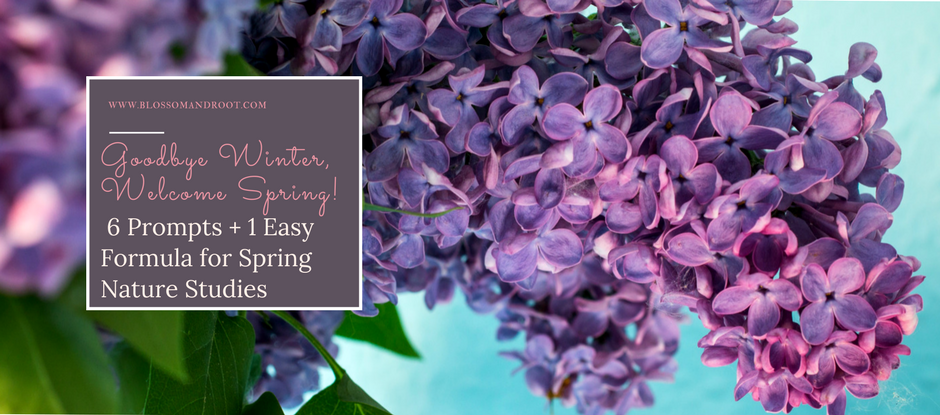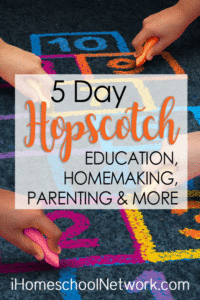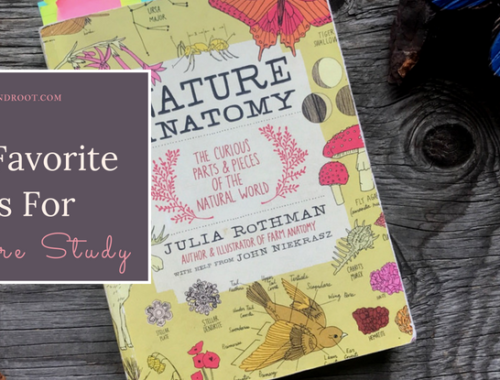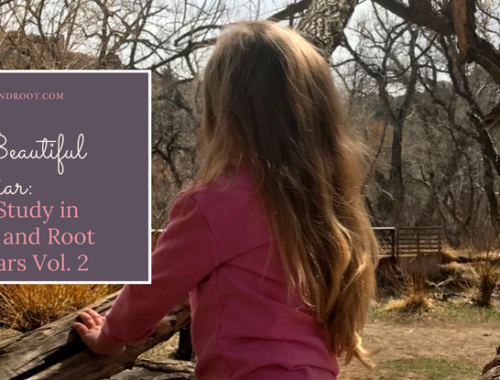The seasons in Colorado, especially spring, aren’t exactly clearly-defined. Just the other day, I took the dogs on a morning walk through icy sleet, only to enjoy a hot, sunny afternoon at the park with the girls mere hours later. We dance between snow, rain, hail, and sunny 80 degree days from mid-March until, sometimes, the beginning of June. Even so, spring is magical. And it’s one of my favorite times to play hooky from table work in pursuit of muddy puddles and new, green sprouts.
Springtime was made for nature studies. We become naturally curious and pulled to the outdoors with the return of birdsong and blooms. It is also one of the easiest seasons for planning nature studies–it’s positively ripe with learning opportunities. It doesn’t have to be complicated, and you don’t need to spend hours planning perfect unit studies for each week’s explorations. In fact, there is an incredibly simple formula you can follow for inspired, yet effortless, nature studies all spring long:
Step One: Take One Beautiful Book…

Choose a beautiful picture book to read to your child. You can go minimalist and choose one book a week, or fill your morning basket to the brim with books on a similar topic. There are so many excellent spring-themed books to choose from!
Step Two: Make Space for Open-Ended Exploration Outside
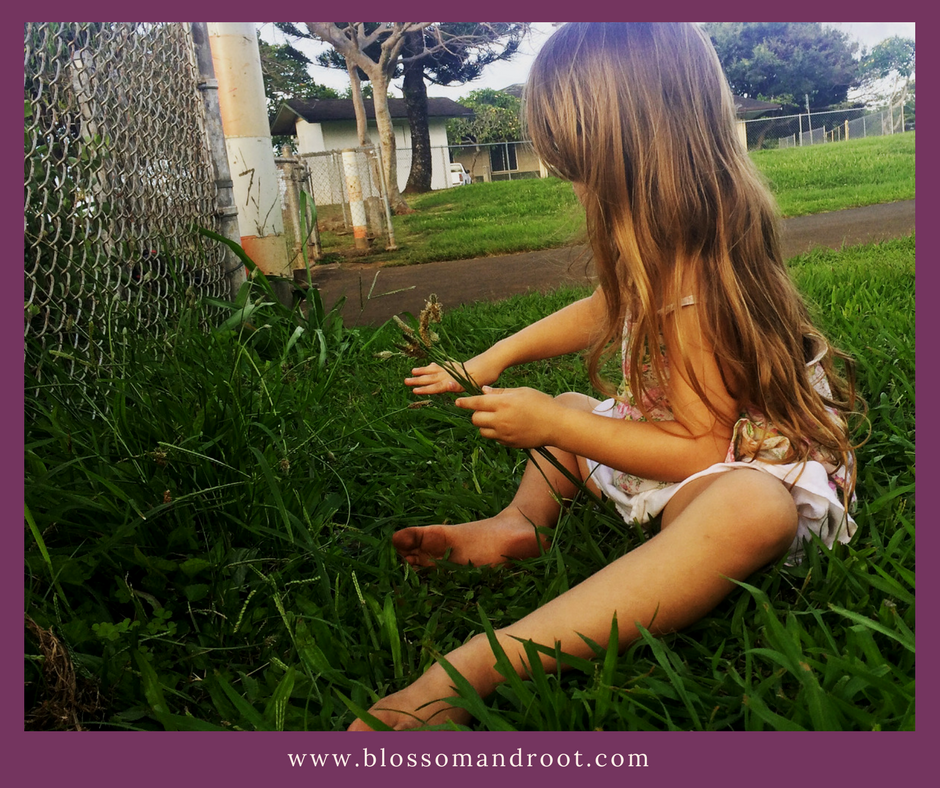
Try to get outdoors in all kinds of weather to truly experience all of the wonder that happens in spring. Give your child room to wander, wonder, and play without expectations or too many directives. Let the book(s) you read together take root in their imaginations and inspire their play. Allow them the freedom to make connections according to their interests, and the tapestry provided by nature on that unique day. I have been surprised on so many occasions by the connections and discoveries the girls made on their own when I have stepped aside and let them lead the way.
Step Three: If Something Sparked, Look it Up!

Did something strike an interest during outside play? Did your child find an interesting insect, flower, or rock that they wanted to learn more about? Did they see tracks in the mud, or find egg sacks floating in the water? If something captured their interest, feed the spark by looking it up in field guides. We keep Rocky Mountain field guides for flowers, trees, insects, birds, tracks and scat, and rocks and minerals on our shelf–and often in our backpack–to look things up. I also refer frequently to Anna Comstock’s Handbook of Nature Studies when something strikes an interest.
Step Four: Record Your Discoveries

Your child’s nature journal is a special place where they can record the interesting and beautiful things they find while at play outside. It doesn’t have to be fancy, and it can happen in many ways. For example, my oldest loves to color and draw, so her journal is filled with watercolor paintings and drawings with pencils and pens. I often write her thoughts down for her in the margins. My youngest does not enjoy coloring or drawing much, but she loves to take photographs. I let her take pictures with my phone, or with her own little digital camera, which we print out and glue in her journal. I really believe in letting their nature journals be their own. I don’t expect neat writing. I don’t correct spelling or grammar. I don’t mind if they spend one day scribbling in a hurry and the next the take an hour to paint a butterfly. Their journal is theirs–a record of their childhood days spent playing and exploring outdoors, to keep forever.
Wash, Rinse, Repeat.
This formula leaves a lot of room for inspiration to take the reins, and for rabbit trails to be followed. If you’ve chosen books about birds, for example, and your child becomes very interested in feathers and flight, you have the freedom to go deeper, spend weeks there if they want. Collect feathers, make a model wing, watch a documentary about how birds fly. Spring is such a wonderful season for curiosity!
6 Excellent Spring Nature Study Topics (and Books to Plant the Seed of Curiosity)
- Soil and Roots (Up in the Garden and Down In the Dirt by Kate Messner and Christopher Silas Neal): explore the soil as it comes to life in the springtime. Collect worms, isopods, and ants to study in a bug house. Investigate how plants take root in different soil types. Notice how last autumn’s decaying leaves have become part of the soil.
- Flowers (Planting a Rainbow by Lois Ehlert): learn about flower anatomy. Notice all of the different flower shapes springing up in the warmer weather. Play “color bingo” and find as many different colored flowers as you can. Bring home a bouquet, take the blooms apart, and organize them by part (petals, stem, stigma, etc.)
- Rainbows (A Rainbow of My Own by Don Freeman): explore the colors of the rainbow. Where can we find rainbows in nature? Learn about how they form. Make a weather log and track the ever-changing weather of spring. Make a rain gauge.
- Nests (A Nest is Noisy by Dianna Hutts Aston and Sylvia Long): look for nests in the natural areas around your home. Can you see eggs inside (without disturbing the nests)? How do different birds make nests?
- Seedlings and Plants (The Tiny Seed by Eric Carle): plant a garden. Plant a seed in a jar stuffed with damp paper towels. Explore seed needs by varying where you plant the seeds. Look for new seedling outside. Can you find where they came from? How did they get there?
- Caterpillars and Butterflies (The Very Hungry Caterpillar by Eric Carle): order butterfly caterpillars online and watch them transition into butterflies, then release them outside. Better yet, raise moths and butterflies at the same time to explore the differences between them. Look for caterpillars outside. Plant a butterfly garden.
Want to go a little deeper and add STEAM activities, art projects, recipes, and delightful word-play to your nature study? Our Spring 2018 Book Seeds Bundle is now available in our Gumroad store! Each issue, inspired by one of the books listed above, dives into STEAM concepts as they apply to the topics in the story, and provides joyful, hands-on activities that can be adjusted for multiple ages. Click here to learn more about Book Seeds by Blossom and Root!
Follow other homeschoolers in the iHomeschool Network Hopscotch:
Get Your FREE Trial Issue of Book Seeds By Blossom & Root!

This FREE issue, inspired by the book The Three Sunflowers by Janet Lucy, includes two weeks of activities including nature study, STEAM, art project, recipe, and exploring language and poetry. Suitable for ages 3 - 8. Grab yours today!

